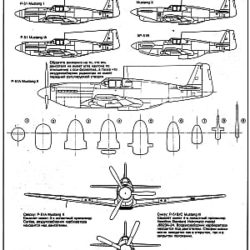North American P-51A Mustang II historical facts
The North American P-51A Mustang II was essentially an A-36 without the dive-bombing equipment. Like the A-36, it had a fixed cooling-air scoop for the radiator. But the L-shaped pitot probe was mounted under the wing as it was on all fighter versions of the Mustang. There was only one landing/taxi light instead of the dual unit found on the A-36. To give the P-51A better performance at higher altitudes the Allison V-1710-81 engine was installed. It had a better supercharger, but it could not match the performance of the supercharger used with the V-1710 in the P-38 or the subsequent Merlin engine. Like the A-36, the P-51A had the air filter in the carburetor scoop, thus causing it to be the wider design.
Originally, 1,200 North American P-51A Mustang II were ordered, but this number was reduced to 310 in December 1942. During the previous month, the first XP-51B had flown with the Merlin engine, and the USAAF opted to buy this new high-altitude version instead. There were already plenty of P-39s and P-40s on hand to handle the low-level chores.
The contracts for this model North American P-51A Mustang II were equally divided between Great Britain and America. From the American P-51A were developed the A-36A dive-bomber and the F-6A photographic-reconnaissance model.
Fifty P-51As were sent to the Royal Air Force where they received the Mustang II designation. Thirty-five of the American aircraft were fitted with cameras and designated F-6Bs.
The first unit to take the North American P-51A Mustang II into combat was the 311th Fighter Bomber Group based in India. This group also flew the A-36, and the use of two very similar aircraft simplified operations, maintenance, and logistics. Other units to operate the type were the Flying Tigers of the 23rd Fighter Group and the 1st Air Commando Group.
The USAAF employed its comparatively small number of P-51As very sparingly, but in the second half of 1943 they started to reach combat unit. First to take the P-51A into action was the 311th FBG. In addition to its 528th and 529th FBSs, which flew a variety of tactical missions including light attack and reconnaissance, the former in particular being associated with the A-36A, the 311th FBG also included the 530th FBS. The unit’s initial base was at Dinjan, comparatively near the border between northern Burma and India, but the 530th forward-deployed to Kurmitola and the famous Allied air base at Cox’s Bazar for its initial long-range forays into action. On 25 November 1943 the 530th flew its first major combat mission, escorting B-25 Mitchell medium bombers tasked with a raid on the Japanese air base at Mingaladon in Burma. The Mustangs carried 75 US gal underwing fuel tanks for this mission. The Japanese met the raid in force and a number of major air battles ensued, two Mustangs being shot down. The Japanese were flying the highly capable single-engine Nakajima Ki-43 Hayabusa ‘Oscar’ and the twin engine Kawasaki Ki-45 Toryu ‘Nick’ heavy fighter. The 530th achieved its first victory that day when Lt Jame England claimed a ‘Nick’.
Production of the Allison-engined North American P-51 Mustang ended with completion of the last P-51A in the summer of 1943. Total Allison Mustang manufacture, including the prototypes (and assuming that the two XP-51s were additional airframes and not Mustang Mk Is), was 1,583. Of these, at least 763 were supplied to Britain and 816 went to the USAAF, with at least four being used by NAA.





